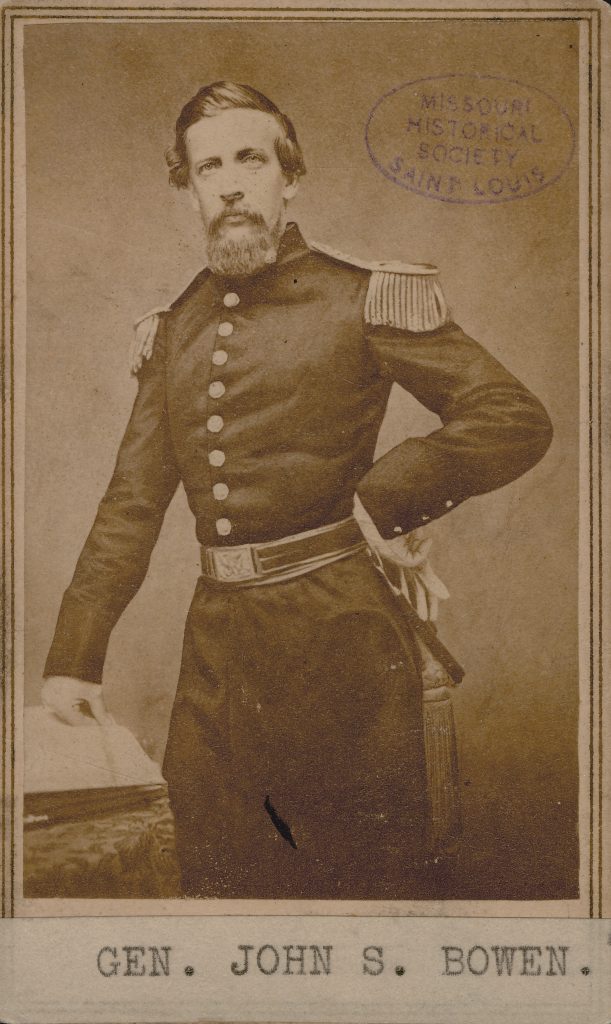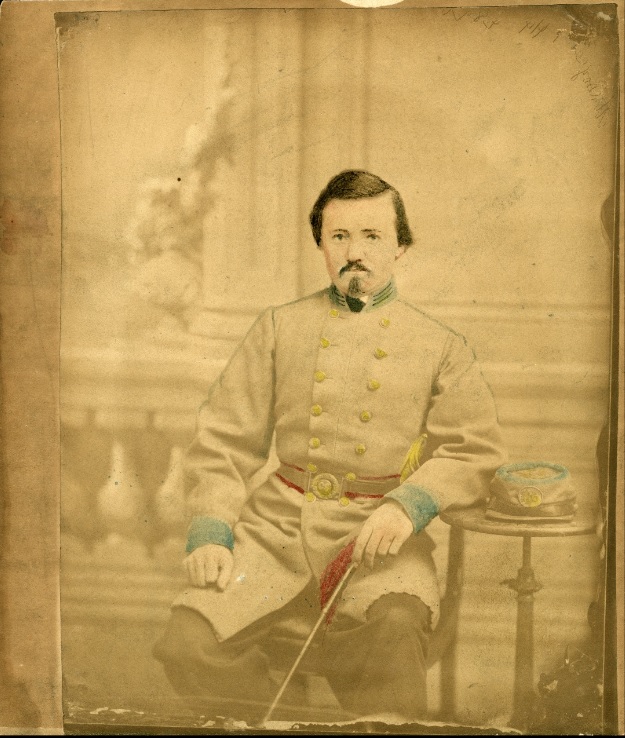Recruiting the Regiment: The First Missouri Confederate Infantry Regiment

For Missouri Volunteer Militiaman and U.S. Army veteran John S. Bowen, it was a tumultuous early summer of 1861. On May 10, he and approximately 600 Missouri militia had been captured by Capt. Nathaniel Lyon’s Federal troops in St. Louis and waited to be paroled. In the meantime, Bowen was impatient and unwilling to wait to join the newly-formed Missouri State Guard. In June, he traveled all the way to Richmond, Virginia to meet with President Jefferson Davis about raising a regiment of Missourians for the Confederacy. Davis granted him a colonel’s commission and the authority to raise Missouri’s first Confederate volunteer unit.
Unable to raise a regiment in Federal-controlled St. Louis – and with the ongoing campaign in south-central Missouri – Bowen raised the First Missouri Infantry Regiment in Memphis, Tennessee. Word spread like wildfire through eastern Missouri that Bowen was raising a regiment of Confederate volunteers. Most the boys came from St. Louis, Pemiscot, Mississippi, and New Madrid counties. One of the enthusiastic St. Louis secessionists was a young 20-year-old Irish Catholic clerk named Joseph Boyce.
Due to his leadership, courage, and devotion to his men, Boyce himself was elected a second lieutenant of Company D, or the St. Louis Grays. In his post-war account of the war, Boyce recalled the early stages of raising and training the First Missouri, as it prepared for combat operations.

“The information spread quickly throughout the city of St. Louis that Col. Bowen wanted us at Memphis. At once the men began leaving in squads of five, ten, fifteen, and less. It was hard work to run the blockade at Cairo, Ill., and Louisville, Ky., but it was successfully done, however, by several hundred of the old 1st Missouri infantry and the Second regiment mentioned above. The men were place [sic] in camps on the Pigeon Roost road, about two miles east of Memphis, and the organization started.
“The regiment remained at this point about two months, when it was ordered to Fort Pillow … We reached this point in due time, but had hardly gotten into camp when we were ordered up to New Madrid, Mo. This news was received with every evidence of pleasure by the command. Again Company B took charge of the boats, and landed us safely the next night about 10 o’clock at our destination. Again we were in Missouri. as we marched ashore we made the woods ring with our cheers for the old state.
“The regimental colors were two large silk flags, one the regulation Stars and Bars, presented to the regiment by the ladies of Memphis, Tenn., the day the command left for New Madrid, Mo., about August 15, 1861. The other one was of rich dark blue silk, heavily bordered with gold fringe. On one side handsomely painted was the seal of the State of Missouri; the reverse bore a picture of a large tigress in the jungle, lying on the grass, with her young cubs at play about her. Beneath this scene on a gilded scroll was in large letters the word BEWARE.
“This flag, a beautiful work of St. Louis artists, originally was the colors of the Second Missouri Infantry organized by Col. Jno. S. Bowen and known as “The Missouri Minute Men.” It was formed about a year before the breaking out of the war. The regiment was captured at Camp Jackson with its brigade, May 10, 1861. The flag, however, was taken away before the final surrender by Mrs. Bowen and later carried through the federal lines at Cairo, Ill., about her body. Upon her arrival at Memphis, she presented it to our regiment and the name “Second” changed to “First Missouri Confederate Infantry.”
“The enlisted men, exclusive of officers, numbered at least 1,000 the day after the regiment was organized. It was reported for duty, every officer and man present. Not one on the sick list. Everybody present and for duty. This was so remarkable in a regiment so large that Gen. Pillow (for we are assigned to his brigade) had us formed and complimented Col. Bowen and the command.
“All the officers were formed into a company and put through the manual of arms and company movements daily by our field officers … In fact, we received such instructions of this kind as is given at the Military Academy at West Point.
“It was absolutely necessary that an officer of the regiment should be able not only to drill his company, but to take command of the regiment and manoeuvre it … This company found this experience of vast advantage to them afterwards when they charged the enemy in earnest. It gave the regiment great confidence in the bayonet, and our favorite movement was double quick and charge bayonets.
“After six weeks hard drilling we were ordered up to Columbus, Ky., and encamped on one of the high bluffs just north of the town. The only thing worthy of mention in regard to the enemy while encamped here was the shelling of our camp one afternoon by the gun-boats Conestoga and Lexington. These boats would come down the river almost day from Cairo and give us a little artillery practice. With the exception of one day, their shells always fell short of camp.
“I wish to say that while here Gen. Albert Sidney Johnston took command of the army and he reviewed us. He was so well pleased with the bearing and movements of the command that he ever afterward called for the First Missouri when he wanted a thoroughly reliable regiment. He was well acquainted with Col. Bowen in the old army and our Lt. Col. Rich was with him on the Salt Lake or Utah campaign.”
The First Missouri Infantry went on to fight at Fort Donelson, Shiloh, and Corinth. Heavy losses at Corinth forced the First Missouri Infantry to combine with the Fourth, creating the First and Fourth Combined Missouri Infantry. The First and Fourth Combined was one of several Missouri regiments that formed the famed Missouri Brigade of the Army of Tennessee, notably serving at Champion Hill, Kennesaw Mountain, the Siege of Atlanta, Franklin, and Fort Blakely. Like the unit itself, which suffered heavy losses at several Western battles, Boyce was wounded at least five times in combat at Shiloh, Corinth, Tuscumbia River, Alatoona Pass, and Franklin. Yet, he continued to fight and serve with his men until war’s end.
Sources:
Captain Joseph Boyce and the 1st Missouri Infantry, edited by William C. Winter (St. Louis, MO: Missouri Historical Society Press, 2011), 32-39.

Boyce is a great resource. I am using him a lot in my Shiloh work.
Thank you for reading and commenting, Sean! Glad you have read through Boyce. It is a great resource. What kind of Shiloh project are you working on?
Thanks for asking. I am doing The Maps of Shiloh for Savas and hopefully a two volume set on the battle.
Boyce’s memoirs just today helped me figure out which Confederate battery was most likely at Wicker Field at 9:00 a.m. on April 7. He calls them the “Georgia Battery” but the only Georgia Battery was the Washington Artillery. Which is easily confused with the more famous 5th Company Washington Artillery. I am 90% sure the Georgia one was elsewhere, but looking at what two members of the 5th Company wrote, I figured out that they were most likely with Boyce in the day’s opening round of combat.
It looks like the Washington Louisiana Battery was located at Duncan Field instead of Wicker Field. It was more likely it was Robertson’s Alabama Battery of three guns.at Wicker Field April 7th.
The Missouri Brigade deserves more recognition. It served from Lexington, MO to Fort Blakely, AL.
In the election of 1860 Missouri voters gave over seventy percent of their votes to the moderate candidates, Northern Democrat Stephen Douglas of Illinois and Constitutional Union nominee John Bell of Tennessee. Lincoln received only ten percent of the Missouri vote, most of that in the St. Louis area. The state convention in early 1861, called by the legislature to “consider the relations of the State of Missouri to the United States” (i.e. secession?), did not include a single secessionist among the elected 99 delegates from the 33 state senatorial districts. Resolutions voted by the convention clearly reflected the political middle ground. Although a substantial majority of Missourians were moderates on the issues of slavery and secession, factions at each end of the political spectrum in St Louis began to organize and arm.
Seizure of federal arsenals in the seceded states and growing secessionist agitation in St. Louis raised concern about the security of the St. Louis Arsenal, a major repository of arms and ammunition. A company of U.S. Infantry, commanded by Captain Nathaniel Lyon, was transferred from Fort Riley, Kansas in early February to protect arsenal stores, augmenting the existing small contingent of federal troops. Growing tensions in St. Louis, caused in part by imprudent actions of Lyon, now brigadier general of volunteers, created serious concern. Influential political moderates persuaded pro-Southern Governor Jackson and former governor Sterling Price, now the commander of the newly-formed Missouri State Guard, to request a meeting with General Lyon and Frank Blair. The latter principals were also urged to meet with the state officials. Such a meeting was arranged for June 11 at the Planters’ House hotel in St. Louis.
Lyon and Blair, accompanied by aide Major Horace A. Conant, met with Jackson and Price in the governor’s suite. Jackson proposed terms that amounted to an offer of strict neutrality. The State Guard would be disbanded and all military preparations would be halted if the Union Guard units in St. Louis were disarmed and a pledge made not to occupy state localities not already held by federal troops.
Blair was to be spokesman for the national government, but the vituperative Lyon soon dominated the discussion. In an appalling consummation of bad judgment and disregard for the neutral position on secession held by the majority of Missourians, Lyon rose from his seat and stared directly at the governor declaring “that the blood of every man, woman, and child within the limits of the state should flow than she should defy the federal government.” Nathaniel Lyon had just declared war on the State of Missouri, a still-loyal state! Even Frank Blair was stunned but did nothing to mitigate Lyon’s egregious declaration.
Taking Lyon’s declaration of war very seriously Jackson and Price left hastily by train that afternoon to return to Jefferson City. Within forty-eight hours General Lyon spearheaded a force of over 2,000 federal troops ti disperse state forces gathering at Jefferson City and to occupy the key river cities. The Missouri State Guard was now an ally of the Confederate Army forces by virtue of a common enemy.
The Missouri State Guard linked up with the Confederate States Army under McCullough, and the Arkansas Army under Pearce in southwest Missouri. Lyon’s federal force attacked them at Wilson’s Creek just southwest of Springfield on August 10, 1861. Outnumbered two-to-one, and employing Lyon’s flawed battle plan, the federal army was soundly defeated, and Lyon was killed. The Missouri State Guard integrated into the Confederate Army in early 1862.